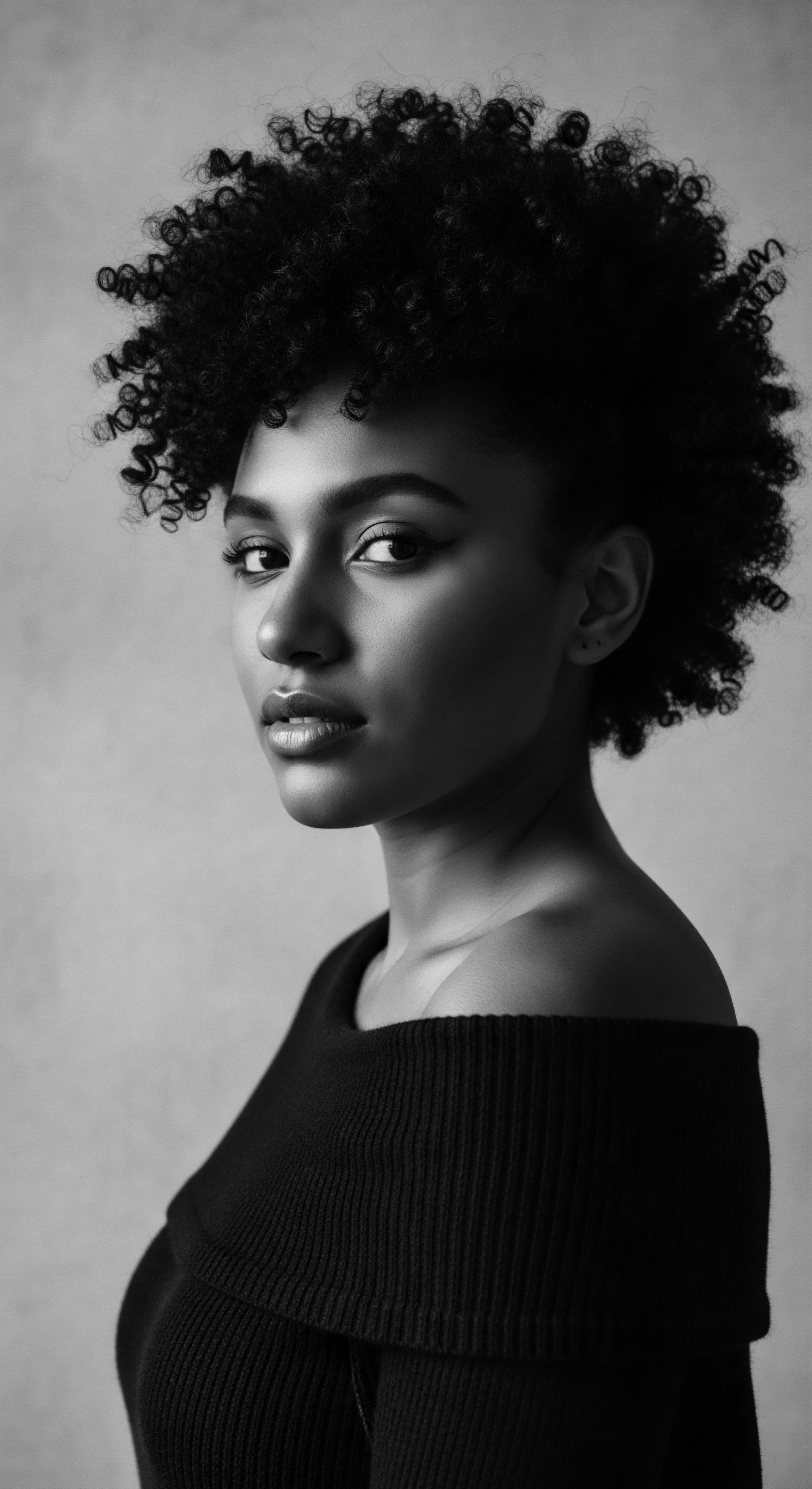
Roots
The very strands that crown us carry echoes of time, stories whispered across continents and generations. For those with Afro-textured hair, this connection reaches back to ancestral lands, to practices held sacred, and to a profound understanding of nature’s bounty. It is a story not solely told in modern product aisles, but one steeped in the rich soil of collective memory, in the wisdom of grandmothers, and in the scientific revelations that now affirm what ancient communities always understood. Our exploration of traditional oils nourishing Afro-textured hair begins here, at the source, acknowledging hair as a living archive of heritage.
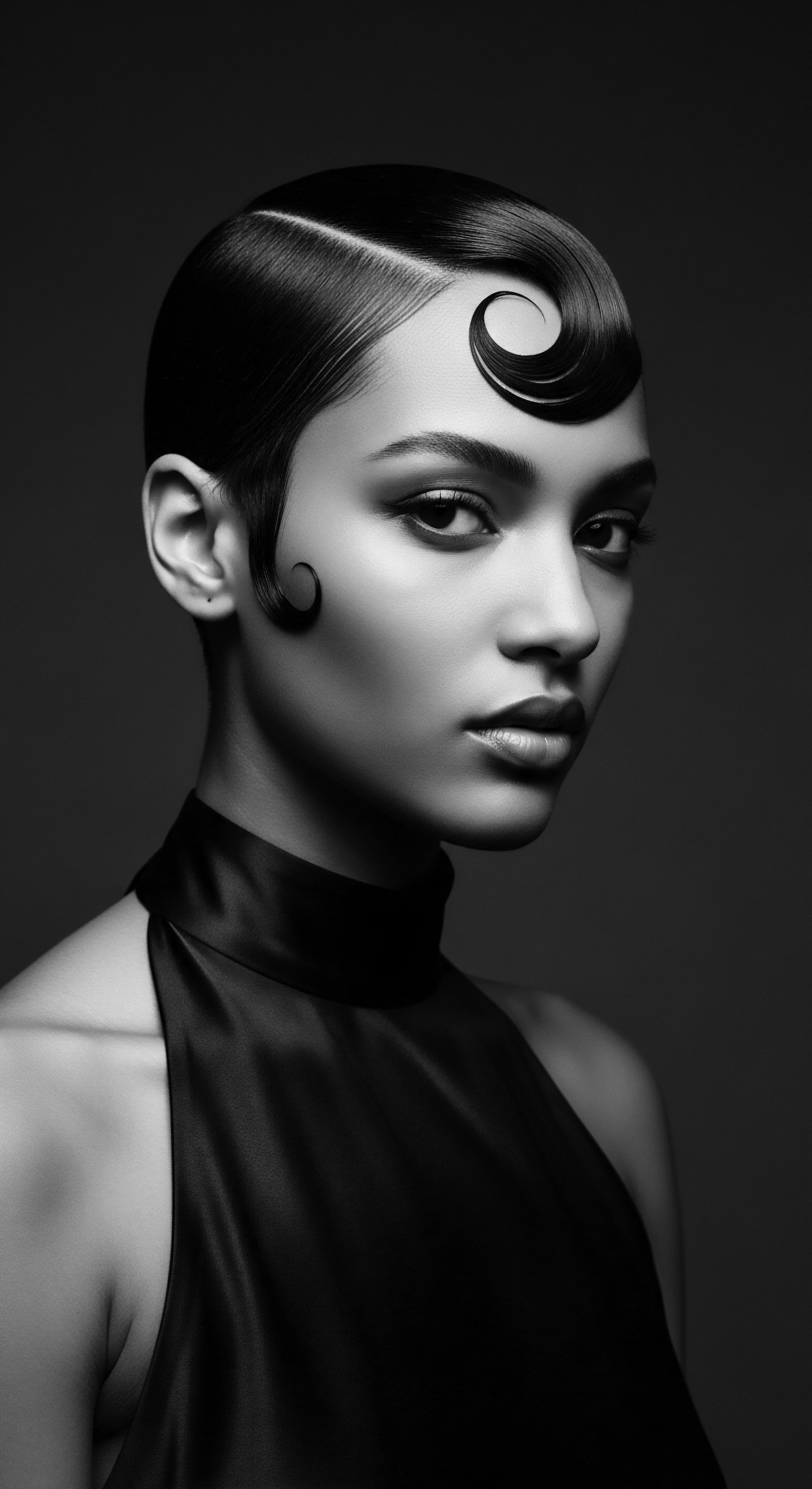
A Hair Biology Reflection
Afro-textured hair, in its myriad forms, from loose coils to tight z-patterns, holds unique biological characteristics. Its elliptically shaped follicles produce strands that curl, coil, and zig-zag, forming beautiful, protective configurations. This geometry, while visually stunning, means the natural oils produced by the scalp, known as sebum, face a more circuitous path traveling down the hair shaft. As a result, Afro-textured hair often experiences a propensity for dryness compared to straighter textures.
This inherent characteristic, understood intuitively by ancestors long ago, laid the groundwork for the ingenious use of traditional oils. The very structure of this hair type, an evolutionary marvel shaped by sun and climate for protection, also meant a greater need for external lubrication and sealing. Ancient peoples observed this truth, long before microscopes revealed follicular cross-sections, and they responded with remedies born of their surroundings.
Afro-textured hair, with its remarkable coiling architecture, historically invited the application of external oils to supplement natural moisture.

Ancient Hair Understandings and Classifications
Long before the advent of modern hair typing systems, African societies held intricate understandings of hair. Hair was, and remains, a powerful symbol ❉ an indicator of tribal affiliation, social status, marital standing, age, and spiritual connection. Hairstyles were a form of communication, often conveying complex social codes (Bebrų Kosmetika, 2024). The care practices that accompanied these styles were equally deliberate.
While formal classification systems might not have existed in the scientific sense we know today, communities recognized differences in hair characteristics and adapted their care accordingly. A denser, more coiled texture might receive a heavier application of a particular butter, while a looser pattern might benefit from a lighter oil, all determined through generational observation and communal sharing of knowledge. This nuanced approach, rooted in lived experience and shared tradition, forms a foundational part of our hair heritage.
- Himba Otjize A paste of butterfat and red ochre used by the Himba tribe in Namibia, not only for cultural symbolism but as a practical protectant against sun and insects (Bebrų Kosmetika, 2024).
- Igbo Jigida Glass beads used by Igbo women in Nigeria to adorn their hair, signifying good luck and fertility, highlighting hair’s role in cultural identity and adornment (Bebrų Kosmetika, 2024).
- Maasai Braids Long braids worn by Maasai warriors, symbolizing battle readiness and strength, showcasing hair as a statement of identity (Bebrų Kosmetika, 2024).

The Enduring Lexicon of Hair
The language surrounding Afro-textured hair care speaks volumes about its heritage. Terms like “locs,” “braids,” and “twists” have ancient lineage, with origins stretching back thousands of years. Consider the dreadlocks, often linked to Jamaica, yet with origins in ancient Ethiopia, worn by Nazirites as a sign of spiritual devotion (Bebrų Kosmetika, 2024). The use of these words, alongside the application of oils, is a continuum, bridging historical practices with contemporary routines.
The very act of naming these styles and ingredients connects us to those who came before, affirming a shared lineage of beauty and resilience. The ancestral approaches to caring for hair, often emphasizing moisturizing butters and oils, inform our understanding of hair health today, allowing a fuller appreciation of these care practices.
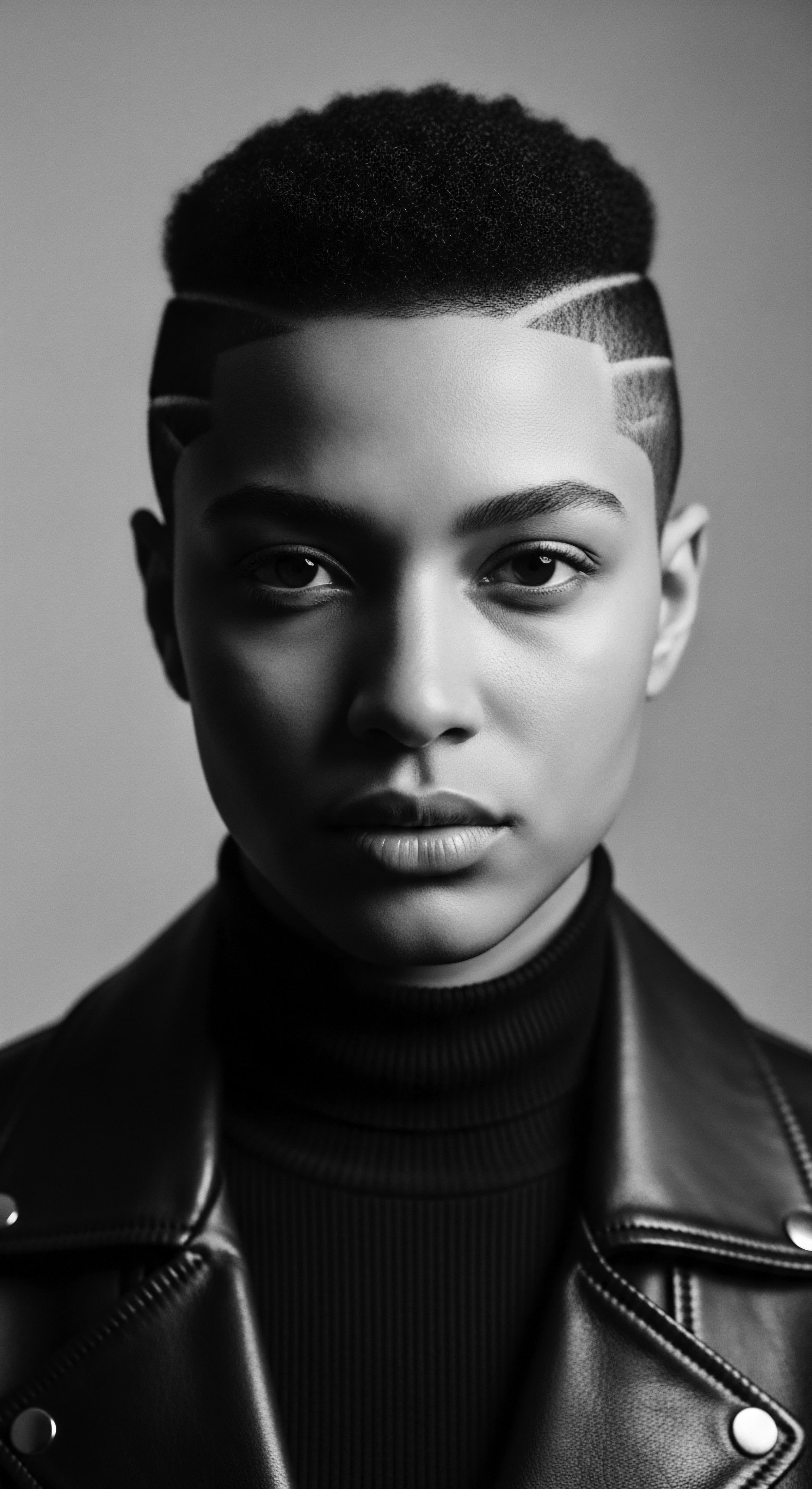
Ancestral Wisdom and Hair Cycles
Hair growth is a cyclical process, influenced by a multitude of factors, including nutrition, environment, and overall health. Ancestral communities, living in close communion with their environments, understood these connections. Their diets, often rich in local, unprocessed foods, supported holistic well-being, which in turn contributed to healthy hair. Traditional oils were not just superficial applications; they were often part of a broader wellness philosophy, supporting scalp health, which is the foundation for hair growth.
The concept of nourishing the scalp to encourage strong, vibrant hair is not a modern discovery. It is an understanding deeply embedded in the practices of those who lived generations ago, a testament to their keen observation and intuitive knowledge of the body and its connection to the earth’s offerings.
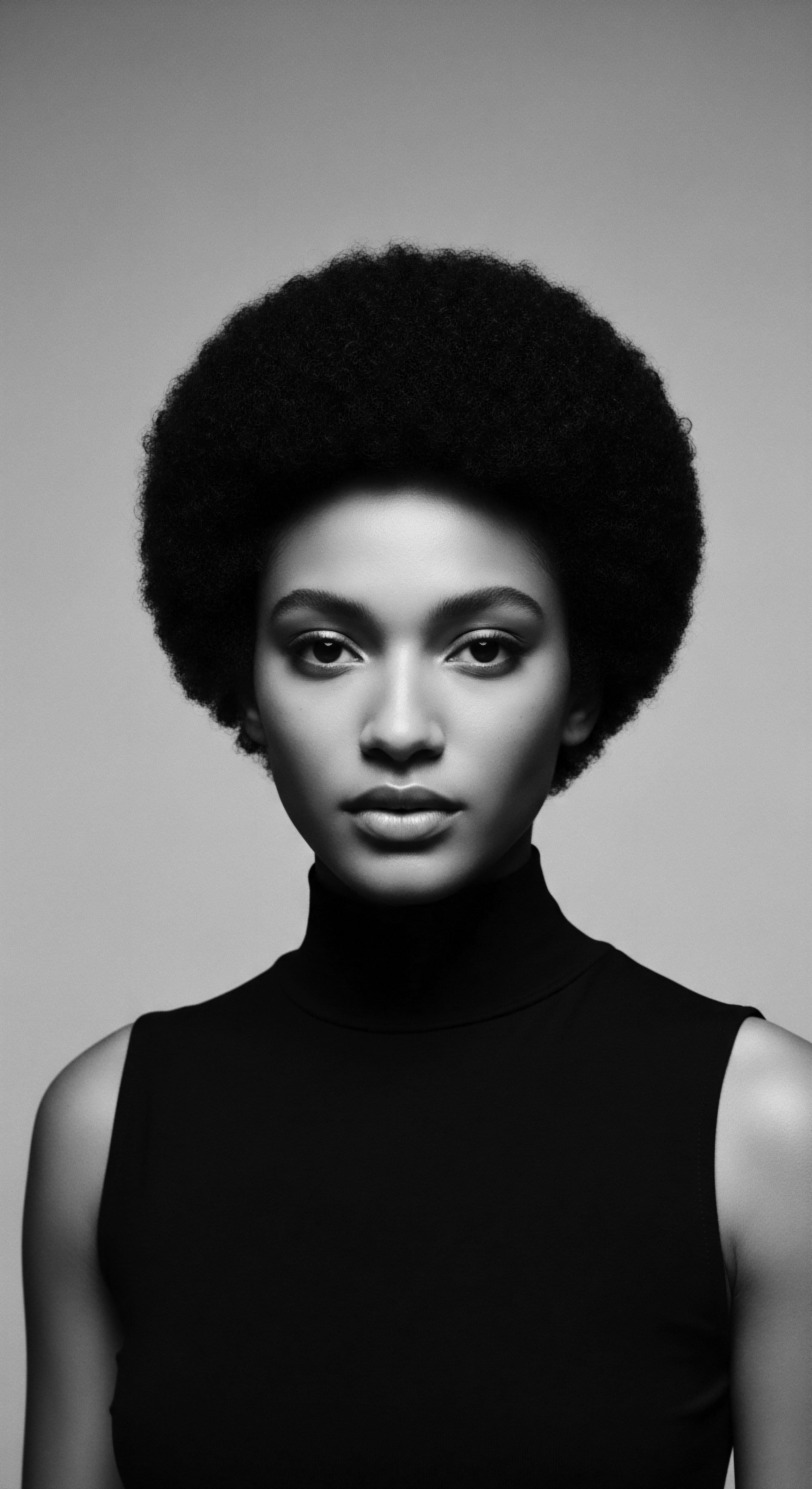
Ritual
Hair care for Afro-textured strands transcends simple grooming; it is a sacred practice, a ritual steeped in connection and profound historical resonance. The application of traditional oils to hair is a deliberate act, one that carries the weight of ancestral wisdom, infusing each strand with sustenance and meaning. This section uncovers the deep influence of these oils within the historical and contemporary artistry of textured hair styling, reflecting a living heritage.

Styling Techniques and Oil’s Historical Role
The historical canvas of Afro-textured hair is a landscape of intricate styling techniques—braids, twists, cornrows, and coils—each with its own purpose, its own story. These styles were not merely aesthetic choices; they were often protective, designed to safeguard delicate strands from environmental elements and daily manipulation. Traditional oils were an indispensable companion to these practices. They provided the slip necessary for smooth sectioning and braiding, the emollient properties to seal in moisture, and the sheen that indicated health and meticulous care.
Consider the communal gatherings where hair was styled, a practice documented in many African societies, where it served as a social event, strengthening community bonds (Bebrų Kosmetika, 2024). During these moments, the application of nourishing oils was a shared act of tenderness, a quiet affirmation of belonging and collective heritage.
The historical use of oils within intricate Afro-textured hair styling underscores a communal and protective approach to hair care.

Protective Styling ❉ An Ancestral Legacy
Protective styles, a cornerstone of textured hair care today, have ancient roots. From intricate Fulani braids to Bantu knots, these methods minimized exposure, reduced breakage, and preserved length. Traditional butters and oils were critical elements in these ancestral protective styling regimens. They were used to coat strands before braiding, offering a barrier against dryness and friction.
After styling, they sealed the ends, preventing moisture loss and fortifying the hair against damage. For example, shea butter, a staple from West Africa, served as a sealant to keep moisture locked into hair and increase softness for curly and coarse textures (Healthline, 2018). This practice allowed styles to last longer and promoted hair health during periods of non-manipulation. The continuity of these practices, from ancient village life to modern cityscapes, speaks to the enduring efficacy and cultural significance of these methods.
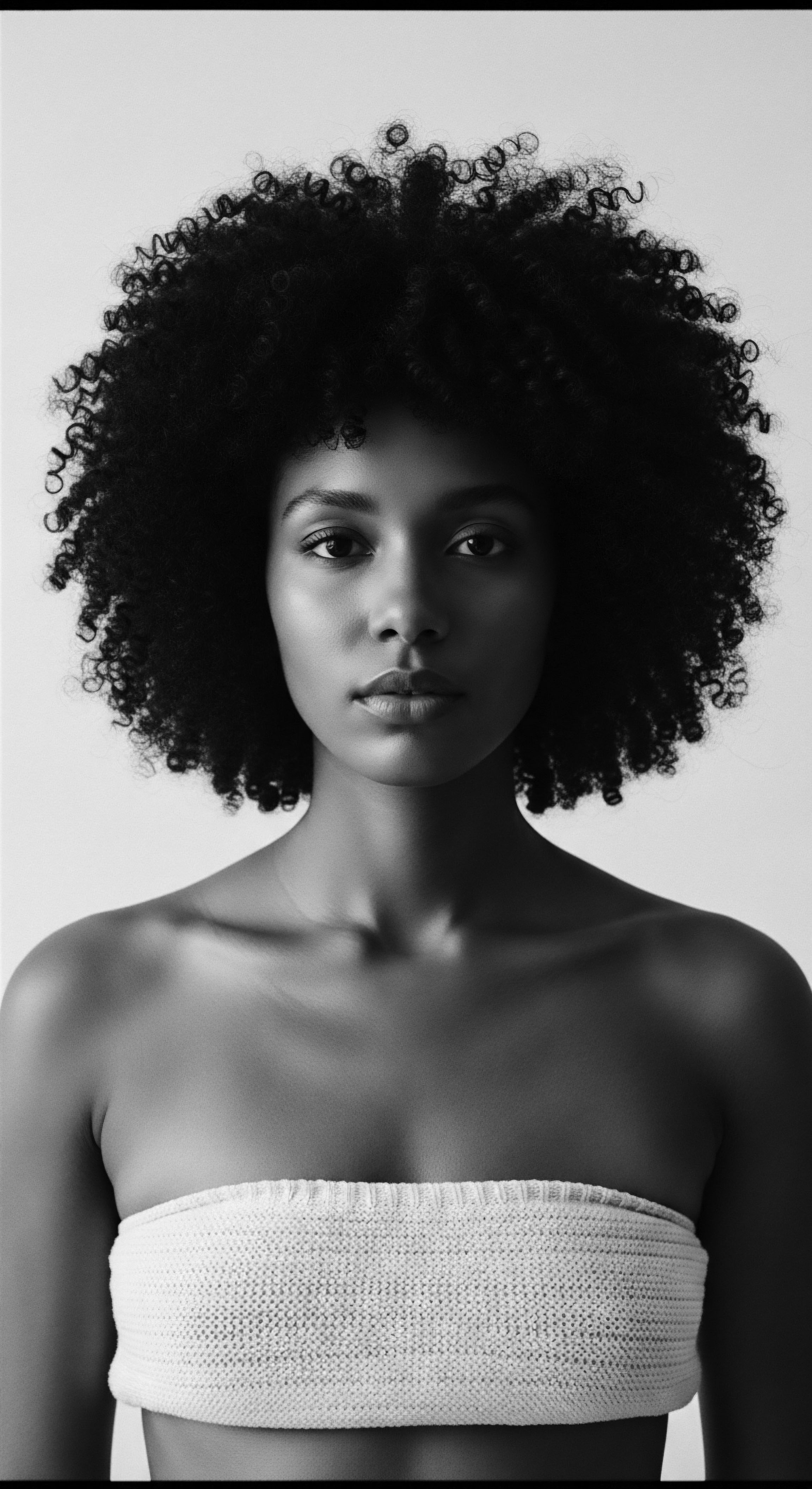
Defining Natural Patterns with Ancient Ingredients
Before chemical treatments sought to alter hair’s natural state, the beauty of coily and curly patterns was celebrated and enhanced through natural means. Traditional oils were fundamental in defining these inherent textures. Light applications could separate curls, lending a soft definition, while richer butters could clump coils, creating more pronounced patterns. This was an art passed down, an intuitive understanding of how different oils could bring out the hair’s natural inclination.
Women in traditional African societies often massaged their scalps with oils to keep their hair healthy, a practice proving its effectiveness throughout the ages (Mango Butterfull Cosmetics, 2022). This gentle encouragement of hair’s true form, rather than its alteration, represents a profound connection to self and heritage.
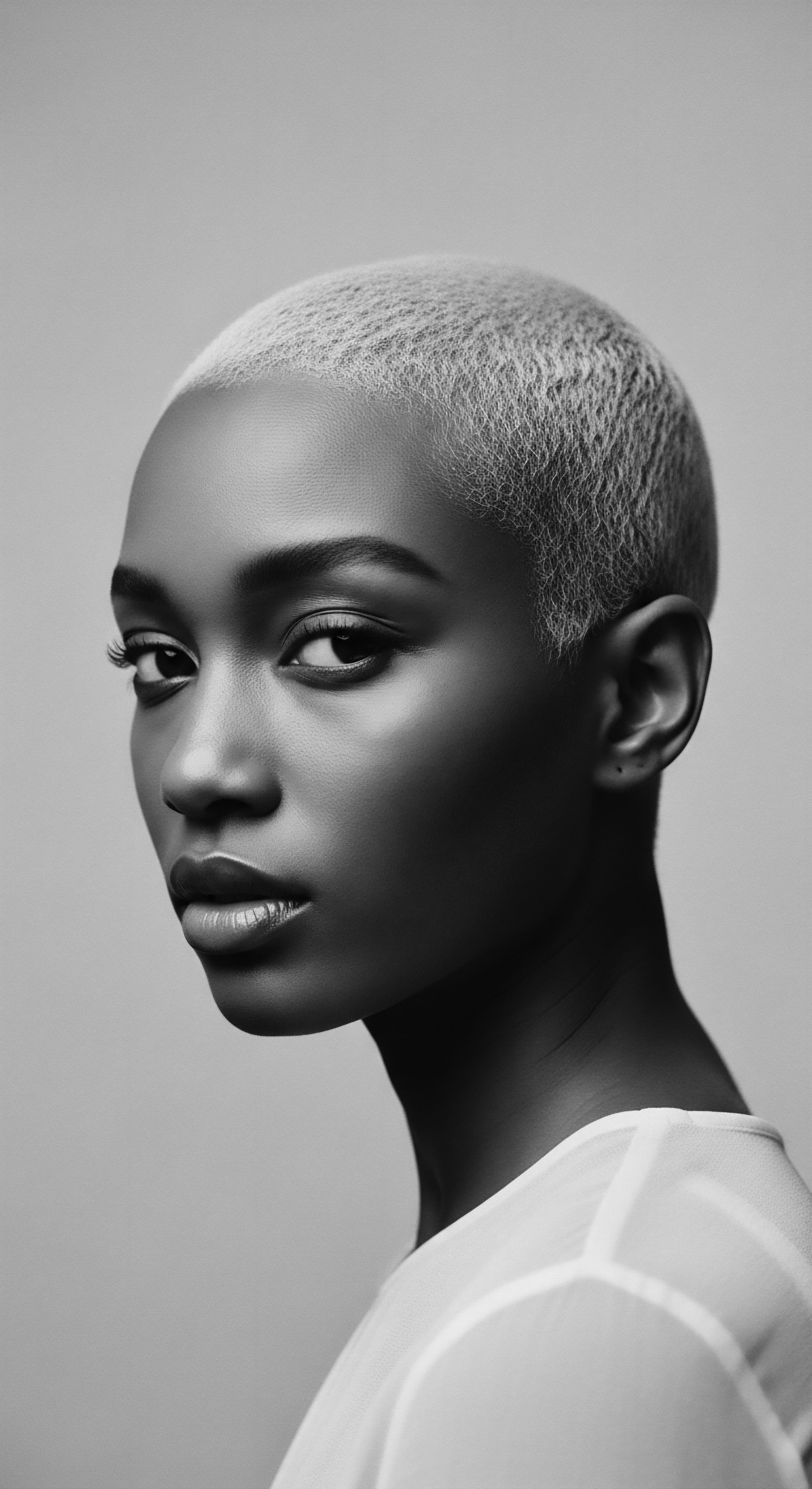
The Tools of Care and the Oil’s Companion
Traditional hair tools, often carved from wood or bone, were not just instruments; they were extensions of care, part of a holistic hair ritual. The Afro comb, for instance, held significance as a status symbol and a practical tool in Kemet and West African cultures (GirlsOnTops, 2020). These tools were often used in conjunction with oils. A wide-tooth comb, perhaps crafted from a specific local tree, would glide through hair made pliable with oil, reducing tangles and breakage.
The application of oil often preceded or accompanied detangling sessions, making the process kinder to the hair. This integration of natural tools and traditional oils speaks to a complete system of care, one where every element contributed to the vitality and beauty of the hair, honoring its deep ancestral connection.
| Historical Period/Context Ancient Egypt (circa 4000 B.C. onward) |
| Oils and Their Traditional Application Castor oil and almond oil used for lamps, medicinal purposes, and cosmetic salves; Cleopatra used castor oil for eyes and body anointing (Qhemet Biologics, 2024; Etre Vous, 2023). |
| Modern Understanding or Continuation Castor oil recognized for ricinoleic acid, which helps strengthen hair, increase flexibility, and provides antimicrobial properties (ResearchGate, 2021). |
| Historical Period/Context West Africa (Millennia ago to Present) |
| Oils and Their Traditional Application Shea butter as a daily protectant from harsh climates, for healing, and to maintain hair moisture (Beauty Garage, 2024; Healthline, 2018). Oils used for hair care composed 14% of citations in a study of traditional oil uses in Burkina Faso (Ethnobotany Research and Applications, 2013). |
| Modern Understanding or Continuation Shea butter remains a popular sealant for moisture and scalp health, its fatty acids and vitamins hydrating and preserving hair (Regirl, 2020; YouTube, 2021). |
| Historical Period/Context Southern Africa (Ancient times to Present) |
| Oils and Their Traditional Application Marula oil, known as "liquid gold," used for skin and hair, absorbed easily without greasiness, and for general wellness (Pydana Collection, 2021; Healthline, 2022). |
| Modern Understanding or Continuation Marula oil, rich in omega-9, vitamin C, and phytosterols, helps prevent water loss, nourishes strands, and soothes the scalp (Pydana Collection, 2021; Healthline, 2022). |
| Historical Period/Context Caribbean (Post-Transatlantic Slave Trade) |
| Oils and Their Traditional Application Jamaican Black Castor Oil, originating from African medicinal practices, cultivated and processed traditionally for hair and scalp conditions (Qhemet Biologics, 2024; Fusion Salon, 2024). |
| Modern Understanding or Continuation Jamaican Black Castor Oil is prized for ricinoleic acid, promoting hair growth, reducing shedding, and strengthening follicles (Qhemet Biologics, 2024). |
| Historical Period/Context The enduring practices of hair oiling reveal a consistent thread of nourishment and protection, adapted through diverse ancestral legacies. |

Relay
The dialogue between ancient wisdom and contemporary understanding illuminates the profound role traditional oils continue to play in nourishing Afro-textured hair. This is where the wisdom of ancestral practices meets the precision of modern science, each informing the other in a continuous relay of knowledge, all centered on the enduring heritage of textured hair care.

Building Personalized Regimens from Ancestral Wisdom
The concept of a personalized hair regimen, tailored to individual needs, finds its deepest roots in ancestral practices. Communities understood that hair, like individuals, had unique requirements. The selection of oils, the frequency of application, and the combination with other natural elements were often customized based on climate, hair density, texture, and even life stage. This was not a one-size-fits-all approach.
For instance, in West African traditions, specific oils and butters kept hair moisturized in hot, dry climates, often alongside protective styles to maintain length and health (Cécred, 2025). Modern science now provides the molecular explanations for these intuitive choices, validating the efficacy of practices honed over generations. A regimen rooted in heritage is one that listens to the hair’s needs and responds with time-honored remedies, refined by contemporary insight.

The Nighttime Sanctuary ❉ Protecting Heritage Strands
The hours of sleep, often overlooked in hair care, were understood as crucial periods of rest and protection in ancestral traditions. The practice of covering hair, whether with wraps or head cloths, served a dual purpose ❉ maintaining moisture and preserving the integrity of intricate hairstyles. Applying traditional oils as part of a nighttime ritual—a pre-sleep treatment or a sealing application—prevented moisture evaporation and minimized friction against sleep surfaces.
This simple, yet powerful, act safeguards the hair from potential damage that occurs during movement, reinforcing the importance of consistent, gentle care for delicate textured strands. The bonnet, a ubiquitous tool today, can be seen as a modern echo of these protective coverings, continuing a legacy of safeguarding hair even in repose.

Oils and Hair Nourishment ❉ What Do Traditional Oils Do?
Traditional oils, passed down through generations, possess a remarkable array of properties that nourish Afro-textured hair from the inside out. Their benefits extend far beyond mere lubrication, actively addressing the unique challenges of coily and curly strands.
- Shea Butter (Butyrospermum Parkii) ❉ Originating from the “Shea Belt” of West Africa, this butter has been a symbol of care and resilience for millennia (Beauty Garage, 2024). Its rich composition of fatty acids—oleic, stearic, and linoleic acids—along with vitamins and minerals, allows it to deeply hydrate and seal moisture within the hair shaft (Healthline, 2018; Regirl, 2020). Shea butter acts as an emollient, smoothing frizz and protecting against environmental stress. Massaging it into the scalp can help stimulation and reduce irritation, making it suitable for dry or itchy scalps (Regirl, 2020; YouTube, 2021). Its ability to coat strands also helps in managing frizz, providing a protective barrier against external elements (YouTube, 2021).
- Castor Oil (Ricinus Communis) ❉ Found in ancient Egyptian tombs, with origins in tropical East Africa, castor oil has a long history in traditional medicine and cosmetics across Africa and the Caribbean (Qhemet Biologics, 2024; Fusion Salon, 2024; Etre Vous, 2023). Jamaican Black Castor Oil, a uniquely processed variant from roasted castor beans, is particularly prized in the diaspora (Qhemet Biologics, 2024). It is singular among oils for its high concentration of ricinoleic acid, an unsaturated omega-9 fatty acid, which accounts for 90% of its composition (Qhemet Biologics, 2024; ResearchGate, 2021). This fatty acid has anti-inflammatory properties, can increase blood flow to the scalp, and is linked to promoting hair growth, reducing shedding, and strengthening follicles (Qhemet Biologics, 2024; ResearchGate, 2021). Its humectant qualities allow it to draw moisture to the hair and lock it in, adding softness and pliability to dry, coarse hair (Qhemet Biologics, 2024).
- Baobab Oil (Adansonia Digitata) ❉ Known as the “Tree of Life” in Africa, the baobab tree yields an oil from its seeds that has been utilized for centuries in African communities for medicinal and cosmetic applications (ARKIVE© Headcare, 2023; Nature In Bottle, 2023). This golden-yellow oil is rich in omega-3, -6, and -9 fatty acids, along with vitamins A, D, E, and K, and antioxidants (ARKIVE© Headcare, 2023; Jules Of The Earth, 2023). Baobab oil is a natural conditioner, helping to moisturize dry, brittle hair, reduce frizz, and impart a healthy shine (Jules Of The Earth, 2023). It is particularly effective in repairing and strengthening damaged strands by penetrating the hair shaft and nourishing cuticles (ARKIVE© Headcare, 2023). Its light composition is easily absorbed, providing deep moisture without weighing down the hair (Nature In Bottle, 2023).
- Marula Oil (Sclerocarya Birrea) ❉ Hailing from Southern and West Africa, marula oil is often called “liquid gold” and has been a staple for ages, despite being a more recent addition to the commercial beauty space (Pydana Collection, 2021; Healthline, 2022; Glimja, 2023). Extracted from the fruit kernels, it is high in antioxidants, essential fatty acids (especially oleic acid), and amino acids (Healthline, 2022; Glimja, 2023). Marula oil is lightweight and absorbs quickly, making it effective for hydrating, moisturizing, and preventing water loss (Healthline, 2022; Glimja, 2023). It can nourish hair from root to tip without excessive greasiness, making it beneficial for dry, frizzy, or brittle hair and useful for taming frizz and adding shine (Healthline, 2022; New Directions Aromatics, 2023).
- Moringa Oil (Moringa Oleifera) ❉ Native to parts of Africa and the Indian subcontinent, the moringa tree is revered as the “miracle tree” due to its extensive benefits (NATURAL POLAND, 2023; Treehugger, 2023). Moringa oil, cold-pressed from its seeds, is packed with omega fatty acids, vitamins (A, C, E), minerals, and antioxidants (NATURAL POLAND, 2023; Treehugger, 2023). It acts as an excellent natural conditioner, helping to strengthen hair follicles, add shine and softness, and potentially reduce dandruff and split ends (NATURAL POLAND, 2023; Azienda Agricola Favella, 2024). It can moisturize the scalp, seal split ends, and protect hair color, making it a versatile oil for comprehensive hair health (Treehugger, 2023).

Problem Solving Through Generations
Hair challenges are not new phenomena; dryness, breakage, and scalp irritation have been concerns for generations. Traditional societies addressed these issues with the resources at hand, often turning to plant-based remedies, with oils as a central component. For example, specific oil blends, perhaps infused with herbs, were used to alleviate dry, itchy scalps or to promote stronger growth (Azienda Agricola Favella, 2024; ResearchGate, 2021). The knowledge of which oil to use for which complaint was passed down, refined by trial and error over centuries.
Today, scientific research often validates these time-honored solutions, revealing the biochemical mechanisms behind their effectiveness. The anti-inflammatory properties of certain oils, or their ability to form a protective barrier, explain why they brought relief and improved hair health for our ancestors, a direct connection between ancient practice and modern understanding (Healthline, 2018; ResearchGate, 2021).

Holistic Influences on Hair Health ❉ Ancestral Views
For many ancestral cultures, hair health was intrinsically linked to overall holistic well-being, spiritual balance, and community harmony. Hair was considered an extension of the spirit, a conduit for energy and ancestral communication (Substack, 2025). The act of caring for hair was often ceremonial, a moment of self-connection and reverence. Oils were applied with intention, not just for physical benefit, but as part of a larger practice of nurturing the self.
This deeper connection highlights that the care of Afro-textured hair is not merely about external appearance; it is also about honoring one’s lineage, fostering self-acceptance, and celebrating a heritage of resilience and beauty. This enduring perspective emphasizes that true radiance stems from a balance of internal and external care, a wisdom deeply woven into the very fabric of our hair traditions.
| Cultural Group/Region Himba Tribe (Namibia) |
| Traditional Oil Use in Rituals Otjize paste, made of butterfat and red ochre, applied to hair and skin daily. |
| Symbolic Meaning or Heritage Connection Protection from sun and insects; symbolizes connection to land and ancestors. |
| Cultural Group/Region Ancient Egypt |
| Traditional Oil Use in Rituals Anointing the body and hair with oils, including almond and castor oil. |
| Symbolic Meaning or Heritage Connection Part of royal beauty rituals; associated with health, purity, and possibly spiritual connection. |
| Cultural Group/Region West African Communities |
| Traditional Oil Use in Rituals Regular use of shea butter and other local oils for moisturizing and protection. |
| Symbolic Meaning or Heritage Connection Preservation of hair health in harsh climates; economic sustenance for women ("Women's Gold"). |
| Cultural Group/Region African Diaspora (e.g. Jamaica) |
| Traditional Oil Use in Rituals Jamaican Black Castor Oil for hair growth, strength, and medicinal purposes. |
| Symbolic Meaning or Heritage Connection Adaptation of African practices brought during the slave trade; a staple of cultural heritage. |
| Cultural Group/Region These varied practices underscore that traditional oils served practical needs while reinforcing identity and ancestral bonds. |

Reflection
As we close this contemplation of traditional oils and their enduring place in the care of Afro-textured hair, a singular truth remains. The journey of these potent elixirs, from ancient groves and communal preparations to their affirmation by modern science, is a testament to more than their chemical composition. It is a testament to resilience.
It is a whisper of continuity across the vast expanse of time and geography, binding generations through the tender act of hair care. Each application of shea butter, each massage with castor oil, each protective braid sealed with baobab oil, carries with it not only nourishment for the strand but also a deep reverence for a living heritage.
The ‘Soul of a Strand’ ethos, which guides our understanding, finds its truest expression in this very continuity. Textured hair, in its infinite diversity, serves as a living, breathing archive. Within its coils and kinks reside the stories of survival, artistry, and unwavering identity. The knowledge of which traditional oils nourish these strands is not simply a list of ingredients.
It represents a sustained wisdom, a purposeful connection to ancestral practices that recognized the hair as a sacred extension of self. It is a vibrant legacy, inviting us to honor the profound beauty and inherent strength passed down through time. To engage with these traditional oils is to participate in a timeless ritual, affirming the past, enriching the present, and shaping a future where the heritage of textured hair continues to shine, unbound and magnificent.

References
- Bebrų Kosmetika. (2024). The Power of Hair in African Folklore ❉ Rituals and Traditions.
- Qhemet Biologics. (2024). The History & Benefits of Castor Oil.
- Sellox Blog. (2021). Ancient African Hair Growth Secrets For Healthy Hair.
- ARKIVE© Headcare. (2023). Baobab Oil for Healthy Hair ❉ Uses & Benefits.
- Healthline. (2022). Marula Oil Benefits, Uses, and Precautions.
- Beauty Garage. (2024). Shea Story.
- Pydana Collection. (2021). The 411 on a Superstar Natural Hair Ingredient ❉ Marula Oil.
- Grow Your Food! (2023). Marula Oil.
- Glimja. (2023). Marula Oil 100% Pure Cold Pressed – African Miracle.
- Mango Butterfull Cosmetics. (2022). What is the purpose of the oil bath?
- New Directions Aromatics. (2023). Marula Carrier Oil.
- History of Jamaican Black Castor Oil. (2019).
- YouTube. (2021). Shea Butter and its Uses for 4c Natural Hair.
- Cécred. (2025). Understanding Hair Oiling ❉ History, Benefits & More.
- Jules Of The Earth. (2023). Baobab Oil ❉ Africa’s Ancient Beauty Secret for Radiant Skin and Hair.
- Mmabatho Tshivhase. (2020). Shea Butter and its Uses for 4c Natural Hair.
- Substack. (2025). Ancestral Hair Rituals to Nourish Your Hair and Soul.
- Healthline. (2018). Shea Butter for Hair ❉ Raw, Hair Growth, and Natural Hair.
- GirlsOnTops. (2020). A Sacred Legacy ❉ On Black Hair And The Revolutionary Power of Self-Exp.
- Regirl. (2020). 6 Ways to Use Shea Butter for Natural Hair.
- CleanO2. (2023). Why We Love Baobab Extract for Hair Care.
- Nature In Bottle. (2023). Baobab Oil Organic African – Adansonia Digitata Seed Oil.
- ResearchGate. (2021). Development and Evaluation of Herbal Hair Serum ❉ A traditional way to Improve Hair Quality.
- Noireônaturel. (2023). The Benefits of Natural Products to Enhance Your Textured Hair.
- Ethnobotany Research and Applications. (2013). Potentials for Promoting Oil Products Identified from Traditional Knowledge of Native Trees in Burkina Faso.
- NATURAL POLAND. (2023). Moringa Oil in Africa ❉ Harnessing a Miraculous Superfood for Nutrition, Skincare, and Wellness.
- Treehugger. (2023). 5 Ways to Use Moringa Oil to Soften, Strengthen, and Protect Hair.
- Azienda Agricola Favella. (2024). Moringa Oil ❉ What It Is and How It Benefits Your Skin and Hair.
- Fusion Salon. (2024). Castor Oil and Afro Hair ❉ A Match Made in Heaven!
- Etre Vous. (2023). Here’s why hair oiling is the ancient ritual worth adopting.
